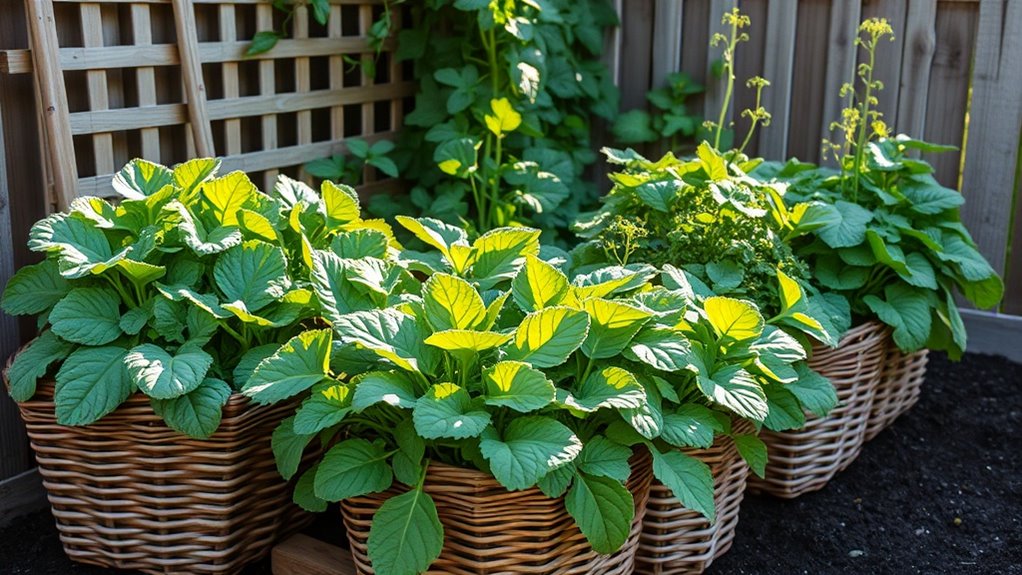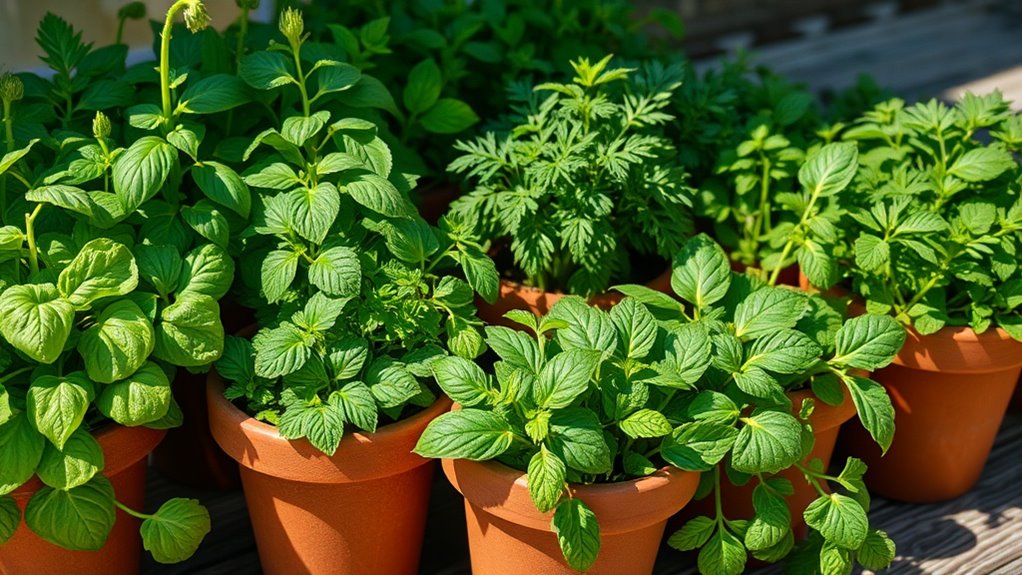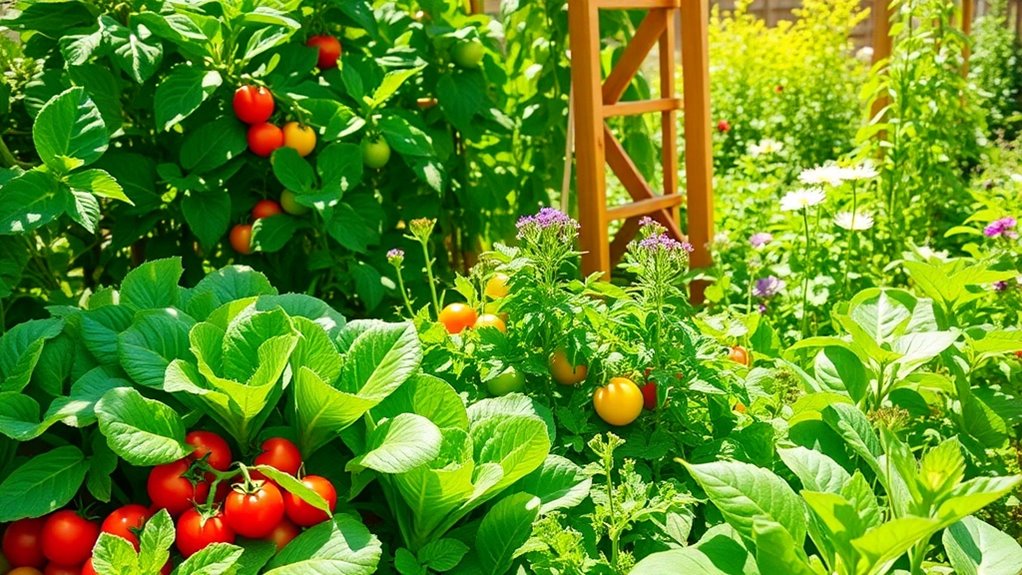Grow These Leafy Greens Without Soil-Here’s How
It’s interesting how many people are unaware that you can grow vibrant leafy greens like lettuce and spinach without soil. Hydroponics offers a fascinating solution, allowing you to cultivate these plants in water with nutrient-rich solutions. If you’re curious about how to set up a hydroponic system and maintain optimal conditions for growth, you’ll find the process not only efficient but also rewarding. Let’s explore the essential steps to get you started.
Key Takeaways
- Select fast-growing leafy greens like lettuce, spinach, and kale for optimal results in hydroponic systems.
- Use Deep Water Culture or Nutrient Film Technique for efficient nutrient delivery to the roots.
- Maintain a balanced nutrient solution with macronutrients and micronutrients for healthy plant growth.
- Provide 12-16 hours of light daily and keep temperatures between 60°F to 75°F for vigorous growth.
- Harvest outer leaves regularly to encourage bushier growth and prolong harvest periods.
Understanding Hydroponics
Hydroponics is a revolutionary method of growing plants without soil, relying instead on nutrient-rich water solutions.
In this system, you provide all essential nutrients directly to the roots, optimizing growth and minimizing disease.
When it comes to hydroponic leafy greens, you’ll find that varieties like lettuce, spinach, and kale thrive in this environment.
The controlled conditions allow for faster growth cycles and higher yields compared to traditional soil-based methods.
Plus, you can cultivate these greens in limited spaces, making hydroponics an ideal solution for urban gardening.
Embrace this innovative approach, and enjoy fresh, healthy produce year-round. Additionally, hydroponics can significantly reduce water usage in agriculture, making it a sustainable choice for the future.
Choosing the Right Leafy Greens
When it comes to hydroponic systems, selecting the right leafy greens can significantly impact your success. Start with fast-growing varieties like lettuce, spinach, and kale, as they adapt well to hydroponic conditions. Consider the space you have; compact plants are easier to manage in smaller setups. Also, think about your local climate and seasonality; some greens thrive better in specific conditions. Lastly, choose varieties that you and your family enjoy eating. Additionally, selecting greens with regrowth potential can enhance your overall yield and sustainability in gardening practices.
Essential Hydroponic Systems
Selecting the right hydroponic system is crucial for successful leafy green cultivation. You’ll find several options, each with unique benefits.
Deep Water Culture (DWC) allows roots to float in nutrient-rich water, promoting rapid growth.
Nutrient Film Technique (NFT) continuously flows nutrients over roots, optimizing oxygen exposure.
Ebb and Flow (Flood and Drain) systems periodically flood the grow tray, ensuring roots receive both water and air.
Lastly, Aeroponics suspends roots in air, misting them with nutrients for maximum efficiency. Additionally, many herbs, such as basil and mint, can thrive in water without soil, making them ideal for hydroponic systems.
Nutrient Solutions for Leafy Greens
When growing leafy greens hydroponically, understanding nutrient solutions is crucial for optimal growth.
You’ll need to focus on essential nutrient components, maintain the right pH level, and select the appropriate fertilizer types and ratios.
Each of these factors plays a vital role in ensuring your greens thrive in a soil-less environment. Additionally, using growing herbs in water can provide a sustainable way to cultivate your leafy greens without the need for soil.
Essential Nutrient Components
As you cultivate leafy greens without soil, understanding the essential nutrient components of your nutrient solution becomes crucial for ensuring optimal growth and flavor.
Your solution should include macronutrients like nitrogen, phosphorus, and potassium, which are vital for plant development.
Additionally, micronutrients such as calcium, magnesium, and iron support various metabolic functions.
Ensure your solution provides a balanced mix, as deficiencies can lead to stunted growth and poor taste.
Regularly monitor and adjust your nutrient levels to match the specific needs of your leafy greens, promoting robust health and maximizing your harvest’s quality.
Ph Level Importance
How can the pH level of your nutrient solution influence the growth of leafy greens? The pH level affects nutrient availability, impacting your plants’ health and yield. Most leafy greens thrive in a pH range of 5.5 to 6.5. Below or above this range, nutrient uptake becomes limited, leading to deficiencies or toxicities.
| pH Level | Nutrient Availability | Effect on Growth |
|---|---|---|
| 5.0 | Limited | Poor growth |
| 6.0 | Optimal | Healthy growth |
| 7.0 | Reduced | Nutrient lockout |
Maintaining the right pH ensures robust, vibrant greens!
Fertilizer Types and Ratios
Proper pH levels set the stage for optimal nutrient uptake, but the choice of fertilizer types and their ratios plays a pivotal role in the growth of leafy greens.
Here are four key fertilizer types and their recommended ratios:
- Nitrogen (N): Essential for leafy growth; aim for a 3:1 ratio with phosphorus.
- Phosphorus (P): Supports root development; use a lower ratio, around 1:1.
- Potassium (K): Enhances overall health; maintain a balanced ratio of 1:1.
- Micronutrients: Include iron, magnesium, and calcium in small amounts for complete nutrition.
Balancing these components ensures robust, healthy plants.
Light Requirements and Growing Conditions
To successfully grow leafy greens without soil, you need to ensure they receive the right light exposure and maintain an optimal temperature range.
Ideally, leafy greens thrive under 12 to 16 hours of light each day, coupled with temperatures between 60°F and 75°F. Using a grow light can help establishing a vibrant indoor salad garden in low-light conditions. Balancing these conditions will enhance growth and yield, giving you vibrant, healthy crops.
Ideal Light Exposure
Light exposure plays a crucial role in the successful growth of leafy greens, as these plants thrive under specific lighting conditions.
To ensure optimal growth, consider the following light requirements:
- Duration: Aim for 12-16 hours of light daily to mimic natural sunlight.
- Intensity: Use full-spectrum LED grow lights for balanced light wavelengths.
- Distance: Position lights 12-24 inches above the plants to prevent burning while providing adequate illumination.
- Cycles: Implement a consistent light schedule, alternating between light and darkness to promote healthy photosynthesis.
Optimal Temperature Range
The optimal temperature range is essential for growing leafy greens successfully, as these plants thrive in specific thermal conditions.
Generally, most leafy greens prefer temperatures between 60°F and 70°F (15°C to 21°C). At these temperatures, they’ll grow vigorously and develop rich flavors.
If temperatures rise above 75°F (24°C), you might notice bolting or bitter leaves. Conversely, temperatures below 50°F (10°C) can stunt growth.
To maintain this ideal range, consider using a thermostat-controlled environment or adjusting your growing area’s ventilation.
Monitoring temperature closely ensures your leafy greens remain healthy, flavorful, and productive throughout their growth cycle.
Harvesting and Maintaining Your Greens
Harvesting and maintaining your leafy greens is crucial for ensuring a continuous supply of fresh produce.
Follow these steps to keep your greens thriving:
- Harvest Regularly: Cut leaves from the outermost parts, allowing inner leaves to grow. This promotes a bushier plant.
- Water Wisely: Keep the growing medium moist but not saturated. Over-watering can lead to root rot.
- Monitor Light: Ensure your greens receive adequate light—12 to 16 hours daily is ideal.
- Fertilize Sparingly: Use a nutrient solution every couple of weeks to support growth without overwhelming the plants.
Additionally, cut and come again greens can provide multiple harvests throughout the season, making them a sustainable choice for home gardeners.
Stay attentive, and enjoy your harvest!





